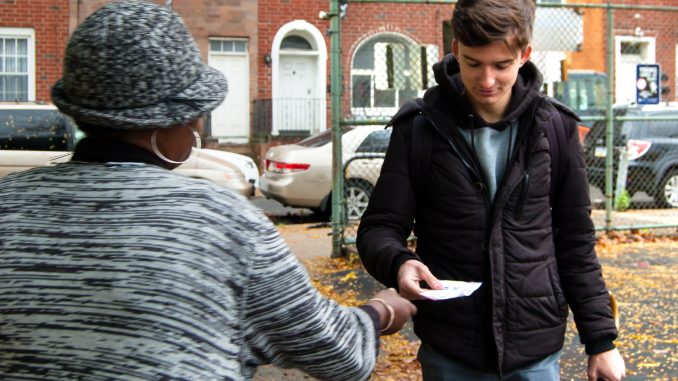
Voter turnout increased by at least 10 percent in each of the five political wards near Main Campus for the 2018 midterm elections in November.
The number of registered voters who cast ballots in 2018 in wards 16, 20, 32, 37 and 47 increased significantly from the 2014 midterm elections, according to data provided to The Temple News by City Commissioner Al Schmidt’s office.
Turnout also increased throughout Philadelphia compared to the 2014 midterms, when the city recorded turnout slightly above the national average.
This year, the turnout in Philadelphia was more than 53 percent of registered voters, compared to the national average of 49.7 percent, according to Schmidt’s office and the United States Elections Project. Still, the five wards encompassing Main Campus recorded lower turnout than the city’s average. Ward turnout ranged from 40 percent in Ward 37 to 46 percent in Ward 32.
There are more registered voters in the state who are 34 or younger than voters ages 65 and older, the Inquirer reported last month.
Voters were more aware of current events and issues for this year’s midterms, said Renee McNair, the Democratic leader of Ward 20, which saw a turnout increase of 19 points.
“There was a huge rise because people are more aware of what is going on,” she said. “In the past, a lot of people had other things to do. This year, people were more educated. I believe that we as a country don’t like the division.”
Shirreefa Fletcher, who lives on Oxford Street near 18th in Ward 47 and is a Temple food service employee, said she turned out to vote in the midterms. Ward 47 recorded 45 percent turnout.
“When I went in, I was in and out,” Fletcher said. “That’s what happens most years. I think a lot more people will come out and vote in 2020.”
Increased turnout could be a positive sign for the political system, said Terry Starks, Ward 20’s Republican leader. The party was defeated by margins of more than 90 percent in races around Main Campus, including state Rep. Malcolm Kenyatta, who won more than 95 percent of the 181st district vote. Democratic leaders were elected in all races on the ballot for voters in the areas near Main Campus.
Despite his party’s defeat, Starks said he was happy to see the public participating in the electoral system and credited it to candidate promises and divisions in the current political climate.
“It’s waking people up who didn’t care about politics,” Starks said. “It’s a gift and a curse for us. The Democrats wanted it more. They use the rappers, the singers and the comedians to drive voters.”
“They did a good job winning the House,” he added.
The Democratic party gained 39 seats in the U.S. House of Representatives in the 2018 midterms and now have the majority over Republicans, who hold 198 seats, the New York Times reported.
Both Starks and McNair said they are anticipating high turnout for the 2020 presidential election because presidential contests historically attract more voters to the polls.
The youth turnout, voters between the ages of 18 and 29, was up from 21 percent in 2014 to 31 percent in the 2018 midterms, according to exit poll projections from The Center For Information & Research on Civic Learning and Engagement, a Tufts University youth civic research group.
Turnout increased this year due to public and youth engagement on key issues like climate change and immigration, said Cyé Jacobs, a sophomore biology major and member of the youth steering committee of #VoteThatJawn, a citywide voter registration effort aimed toward college students and young people.
“A lot of young people, especially in our age range, were very involved with the issues on the ballot,” Jacobs said. “The intensity of partisanship drove people to want their side to make the decisions. …Voices on both sides have gone through the roof.”
Jacobs attributed low turnout in the five wards around Main Campus to the community having a lack of educational resources, low income and being discouraged from voting. The 2020 presidential election is likely to continue citywide growth in voter participation, she said.
About 69 percent of people with incomes less than $29,999 did not vote during the 2014 midterms, according to a 2015 U.S. Census Bureau report. In 2018, the Center for American Progress warned that low-income voters were suppressed from voting for various reasons.
To vote, Wesley Midgett, a freshman fine arts major who lives on Berks Street near 17th, returned home to South Philadelphia, where turnout was about 10 points higher than in areas near Main Campus. Midgett attributed increased turnout to social media influence.
“There was a line [at the polls],” Midgett said. “Definitely with social media, these days people find it important to share their news and what they believe in. Voting is so easy, and now the social media generation is old enough where we can vote.”



Be the first to comment